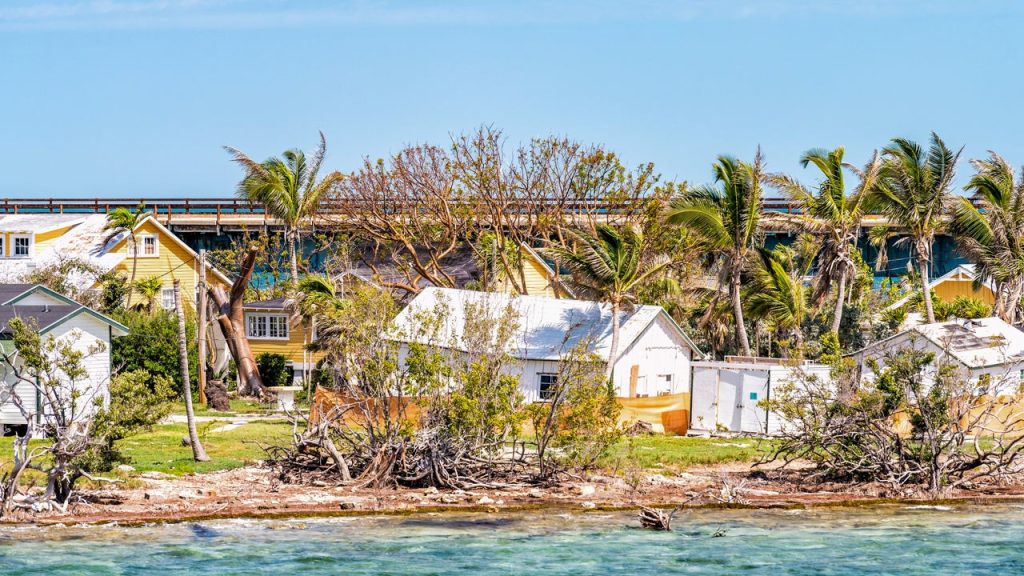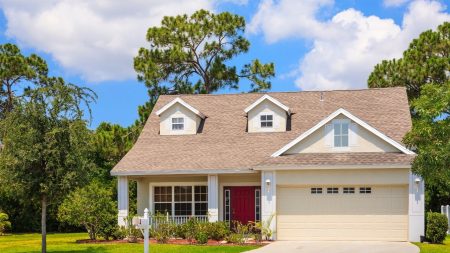Key takeaways
- A standard home insurance policy does not cover all aspects of hurricane damage.
- Flood insurance covers hurricane-related storm surges and flood damage. Mold damage, however, is not included.
- You may have a separate, and higher, hurricane insurance deductible.
- Getting hurricane coverage before the season starts may be the best idea to ensure you have coverage. Typically, there are moratoriums (restrictions) for buying or adjusting coverage when storm warnings are issued.
Hurricane season 2024 is expected to last from June to the end of November, and experts are expecting it to be a particularly bad year for storms. The National Oceanic and Atmospheric Administration (NOAA) predicts an 85 percent chance of an above-normal season this year, largely due to La Nina conditions in the Pacific, warmer Atlantic ocean temperatures and lower Atlantic trade winds. This year, you can expect to see anywhere from 17 to 25 named storms — 8 to 13 of which are expected to become hurricanes.
If you live in the path of a hurricane, you’re probably already familiar with what to do when a storm hits: prepare for power outages, have a go-bag at the ready and evacuate if need be. But another essential part of hurricane prep is to ensure that you’re covered by an insurance policy in case your home is damaged. Your home insurance policy covers some — but not all — of the damage a hurricane can cause. To be fully financially protected from a hurricane, you’ll likely need a flood insurance policy in addition to your home policy. Depending on your state, you may also need wind insurance.
Resources for Hurricane Helene and Hurricane Milton
Between late September 2024 to early October 2024, the American Southeast experienced two back-to-back hurricanes, Category 4 Helene and Category 5 Milton. If you’ve been affected by either (or both) of the storms, here’s what to do:
-
- Listen to all evacuation orders, and do not return to your home until it has been declared safe. If you’re in Florida, you can enter your address on this map to check evacuation orders in your zone. You can also sign up for text alerts and check your county here.
- If you’ve been displaced from your home, contact your insurance company and see if you can access funds sooner. If you can’t live in your home due to an evacuation order or home damage, call your insurance company and see when you can receive money under the additional living expenses part of your policy. This can help with hotel, food and other unexpected costs. If you are already displaced or know that your home will become uninhabitable, it’s possible your company will release claims money to you ahead of time. Insurance companies are more likely to do so during widespread disasters like hurricanes.
- Call your flood insurance provider. If you have an NFIP policy, you can call 877-336-2627 to be connected with an agent. Or, if you have a private flood policy, contact your flood provider.
-
Resources for homeowners affected by Helene and Milton:
- Text “Shelter” and your ZIP code to 43362 for a list of open shelters near you
- Text “DRC” and your ZIP code to 43362 for a list of FEMA Disaster Recovery Centers near you
- If you have an iPhone 14 or newer, or your iPhone is running on iOS 18, follow these instructions to send text messages via satellite (can be available when cell towers go down)
- Red Cross Shelter finder
- FEMA Disaster Assistance Application, or call 800-621-3362. You may be able to receive up to $750 in “Serious Needs Assistance” for immediate expenses like food, water, baby formula, medication and diapers if your home is in a declared disaster area.
- Florida Baptist Disaster Relief Public Assistance: 904-253-0502 or text Helene to 27123
- Check if a hotel is pet-friendly
- Free housing from Airbnb.org
- Florida
- For Pinellas, Hernando, Hillsborough, Charlotte, Escambia, Santa Rosa, Holmes, Washington, Bay, Jackson, Calhoun, Walton, Okaloosa, Gulf, Lee, Hendry, Glades, Leon, Taylor, Wakulla, Madison, Liberty, Gadsden, Franklin and Jefferson counties, contact 211.org
- For Sarasota and Manatee counties, call 863-688-5563 or 800-282-8011
- For Pasco county, call 800-995-7604
- North Carolina: Contact 211.org
- South Carolina: Contact 211.org
- Georgia
- For Effingham, Chatham, Bryan, Liberty, Long, Taliaferro, Wilkes, Lincoln, Colombia, McDuffie, Warren, Richmond, Burke, Glascock, Jefferson and Screven counties, call 211
- For Atkinson, Bacon, Berrien, Brooks, Clinch, Coffee, Echols, Jeff Davis, Lanier, Lowndes and Ware counties, call 229-242-2208
- Florida
- Resources for Floridians affected by Milton
-
- List of shelters by county
- Check if a shelter is pet-friendly or amenable to other needs
- Call 800-729-3413 for evacuation assistance
- Call 211 for updates on school closures and sandbag distributions
- Samaritan’s Purse Hotline 833-747-1234, for free help with removing personal property, furniture, flood cleanup and more
- For a free Uber ride to a shelter in an evacuating county, use code “MILTONRELIEF”
How much hurricane coverage do you need?
Insurance companies don’t sell standalone “hurricane insurance policies,” so you will need to rely on your home insurance policy and some supplemental policies, like flood insurance, to get adequate hurricane coverage. Depending on your circumstances or preferred degree of financial protection, you may need to consider higher coverage limits or coverage add-ons to your policy, above what a standard HO-3 or HO-5 policy provides. Most homeowners policies provide financial protection from windstorm damage for:
- Your dwelling (the structure of the home)
- Detached units (like a shed or detached garage)
- Personal property (your belongings)
- Living expenses if you are displaced
However, in some more hurricane-prone places, wind may not be considered a covered peril. In that case, you would need separate wind insurance.
Dwelling coverage
Dwelling coverage covers the structure of your home, your roof, attached structures and built-in appliances such as your water heater or kitchen cabinets. You generally buy this coverage equal to the total rebuild cost of your home. However, home insurance shouldn’t be a “set it and forget it” type of expense. From 2018 to 2022, home replacement costs have risen by more than 30 percent. If your home’s dwelling limit hasn’t changed in a couple years, you could be underinsured. If raising your dwelling limit is out of your budget, consider adding an inflation guard or extended dwelling replacement endorsement. Depending on your insurance provider, this could be a more budget-friendly approach to limiting out-of-pocket expenses if your home is rendered a total loss.
Other structures coverage
Other structures coverage pays to repair or replace detached structures on your property, including garages, sheds, barns, gazebos, in-ground swimming pools and more. This coverage is based on a percentage, generally 10 percent, of your dwelling coverage limit. For example, if you have $400,000 in dwelling coverage, you may have up to $40,000 in coverage for detached units. Your yard and detached structures can sometimes bear the brunt of hurricane damage. Make sure your dwelling limit includes enough coverage for the other structures on your property.
Personal property coverage
Personal property insurance covers your personal items, like clothing, furniture and appliances. Generally, the limit for personal property coverage is a percentage of your dwelling coverage limit. Many insurers provide personal property coverage of 50 to 70 percent of your home’s insured value, according to the Insurance Information Institute (Triple-I).
If you live in a state where hurricanes are common, it’s important to make sure you have enough personal property coverage. For the highest amount of protection, consider insuring your belongings at their replacement cost value instead of their actual cash value. With replacement cost coverage, your insurance company reimburses you for items of equal value to the ones you lost without factoring depreciation.
Additional living expenses
Homeowners insurance helps pay for additional living expenses if you get temporarily displaced after a covered loss, like a hurricane. Your policy may reimburse you for the cost of hotel and food expenses while your home is being repaired. The coverage limit for additional living expenses is sometimes a default amount set by the insurance company, but you might have the option to increase the limits for more protection. In many cases, your additional living expenses coverage is 10 percent of your dwelling limit.
How do hurricane deductibles work for homeowners insurance?
If your homeowners insurance does cover for wind damage or other hurricane damage, then claims may be subject to a separate deductible. These deductibles are typically higher than standard homeowners insurance and set as a percentage – usually 1 to 5 percent – of your dwelling coverage. For example, if you are covered for $400,000 and your hurricane deductible is 5 percent, then you may have to cover a $20,000 deductible, which would be deducted from your claim payment.
Do you need a hurricane deductible?
All Atlantic and Gulf Coast states, as well as Pennsylvania, Washington, D.C. and Hawaii allow insurance companies to require a separate hurricane deductible, according to the Insurance Information Institute (Triple-I). It is possible that you may have the option to pay a higher premium to lower your fixed deductible.
Hurricane deductibles are usually triggered by a hurricane watch or warning issued by the National Weather Service, but can vary slightly by state and insurance company. While hurricane deductibles may be costly compared to your standard home insurance deductible, the coverage is essential protection for those in high-risk areas for hurricanes.
What states have hurricane deductibles?
19 states and Washington, D.C., have hurricane deductibles:
- Alabama
- Connecticut
- Delaware
- Florida
- Georgia
- Hawaii
- Louisiana
- Maine
- Maryland
- Massachusetts
- Mississippi
- New Jersey
- New York
- North Carolina
- Pennsylvania
- Rhode Island
- South Carolina
- Texas
- Virginia
- Washington, D.C.
Additional hurricane coverage options to consider
Flood insurance
Some homeowners may be surprised to learn that flooding — even from a hurricane — is generally not covered by a standard homeowners insurance policy. This is why many lenders require homeowners to carry flood insurance if they have a mortgage. One of the most common ways to get flood insurance is through the National Flood Insurance Program (NFIP).
NFIP policies provide up to $250,000 in dwelling coverage and $100,000 in personal property coverage for residential homes. Before your coverage takes effect, there is a 30-day waiting period, except in a few rare circumstances. Additionally, NFIP flood insurance premiums must usually be paid for upfront and in full, rather than in monthly increments. Many private carriers also offer flood insurance now as well, and the waiting periods may differ from NFIP-backed policies. Private flood policies typically offer higher dwelling and personal property limits than NFIP policies, as well as additional living expenses.
Catastrophic flooding from hurricanes can occur in inland communities as well, as we have seen from several recent storms. More than 20 percent of flood claims come from properties outside high-risk federal flood zones, according to FEMA. Because of this, it may be better to err on the side of caution and buy flood insurance if your area is at all subject to flooding. Otherwise, you could be stuck with the entire bill if your home is damaged by water, says Sara Singhas, director at the Mortgage Bankers Association.
Windstorm insurance
Some insurance companies limit or exclude wind damage from homes in areas at high-risk for hurricane and tornado damage. Homeowners may have the option to purchase wind coverage as an additional endorsement from their current home provider. If not, they may need to secure a stand-alone windstorm insurance policy. Windstorm policies usually have a deductible of 1, 2, 5 or even 10 percent of the dwelling coverage. Some insurers also offer a standard flat deductible for “named storms” so that homeowners are not always required to meet a high deductible for wind damage from smaller storms.
Most homeowners find windstorm policies through non-profit government-backed policies like Louisiana Citizens Property Insurance. By law, these policies have a higher premium than those offered by private insurers, but can be a life-saving option for homeowners with no other way to secure coverage.
Water backup coverage
Sewage overflow is not something you want to think of after a hurricane, but it could happen as a result of flooding. Water backup coverage helps protect your home and personal property from water damage if sewage water backs up into your home through your plumbing or sump pump. An electric sump pump could fail during a hurricane power outage, which could flood your basement.
Debris removal coverage
Homeowners insurance generally covers debris removal if, for instance, a tree falls on your property. However, the coverage usually only goes up to a certain amount. Usually, your insurance policy will cover up to $1,000 for one tree debris removal instance, with up to $500 per tree. Debris removal following a hurricane can easily exceed that cap, so you may want to check if your insurer offers a coverage endorsement to increase your debris removal reimbursement.
Hurricane season 2024
Hurricane season 2024 is shaping up to a record-breaker. The NOAA predicts there will be 4 to 7 major hurricanes, meaning the storms are Category 3 and above. Predictions from the Tropical Weather and Climate Research Team at Colorado State University (CSU) are equally anxiety-inducing for homeowners. CSU anticipates 5 major hurricane and a total of 13 major hurricane days. CSU predicts there is a 34 percent chance that a major hurricane makes landfall along the East Coast, including the Florida Peninsula. The odds are slightly worse for the Gulf Coast and the Florida Panhandle; CSU anticipates a 42 percent change of major hurricane landfall in that part of the country.
Living in the path of a hurricane comes with major financial risks, but understanding your home insurance policy can help mitigate some of those risks. Here’s the run-down of what you need to know about home insurance and hurricanes to help you be ready for the historic 2024 hurricane season:
- Homeowners insurance typically covers some forms of hurricane damage but does not cover flood damage. Homes in high-risk areas may need windstorm insurance and flood insurance to avoid potential gaps in coverage. When a hurricane approaches, most insurance companies put a moratorium on increasing coverage or lowering deductibles until the storm passes.
- Bankrate’s hurricane resources aim to help you understand how your home insurance coverage may financially protect you from storm damage. These guides also provide tips to prepare your home for a storm and resources on how to file a claim for hurricane-related damage.
How to be prepared to make a home insurance claim after a hurricane
To prepare for an insurance claim after a hurricane, there are several things you can do. Take photos and videos of the interior and exterior of your home routinely (every six months to a year) to document what your home looks like and what is in it. If you have done major renovations or repairs, make an inventory of that, too, and upload all of the documentation to the cloud so you can access it remotely.
After a storm, it could take time for an insurance adjuster to inspect your home so document everything again as soon as you can. Moss advises that having your own documentation can help your insurer process your claim more quickly and resolve potential claim disputes.
Do I need hurricane coverage if I rent or own a condo?
When it comes to hurricane protection, renters insurance policies are just as important as homeowners policies are. If you live in an apartment, your landlord insures the building, but you still need to carry insurance for your possessions and additional living expenses. Renters insurance does not cover flood loss, however renters that live in an area prone to flooding may be able to purchase a stand-alone flood policy through NFIP or a private flood insurer.
If you own a condo, find out what areas of the structure are covered by the association and what you will need to insure. In addition to your personal items, it is possible that you may be responsible to help pay for a portion of the repairs to the damaged structure. Check with your association attorney or property management company before you buy and find out exactly what type of coverage you will need under your condo insurance policy. You may also want to have your insurance agent review the master condo policy to help you determine what additional coverage you need for full financial protection. You may need separate flood and windstorm policies to cover damage to attached fixtures and personal property inside your home.
Frequently asked questions
-
There is no such thing as “hurricane insurance” or “hurricane coverage,” but there is insurance to cover windstorm damage associated with hurricanes. For example, some home insurers in coastal regions exclude windstorm damage, so windstorm insurance will need to be purchased separately. Flooding is also a big concern. Home insurers generally do not cover flood damage, so a separate flood insurance policy will be needed.
-
A hurricane moratorium is a period of time after a hurricane is forecast when insurance companies will not write new policies or allow coverage updates to existing policies. The moratorium is usually put into effect once a hurricane watch or warning has been issued by the NOAA.
-
Hurricane damage to your car (like flood and wind damage) is generally covered as long as you carry comprehensive insurance on your auto policy. However, if you have personal items in your vehicle that get damaged due to a hurricane, your homeowners, renters or condo insurance may cover it. That’s another reason why it’s important to have adequate coverage limits for these policies.
-
The cost of flood insurance depends on your policy limits and the degree of financial protection you require, as well as if you purchase from a government flood insurance provider or a private company. Flood insurance from the National Flood Insurance Program costs an average of $800 per year. Your rates will depend on where you live, if you are in a flood zone, the amount of coverage you need, and the deductibles you choose. If you are looking to buy a home soon, shop around with multiple insurance companies to compare pricing and coverage. Finally, it could be beneficial to do more than a skim-read of your policy. Take the time to understand what it includes (and what it does not), how to file a claim and any additional coverage you might need to purchase.
-
Hurricanes are some of the most destructive natural disasters. Your home can sustain serious structural damage after a hurricane, particularly on your roof. Flooding is also a major concern, especially for homeowners with a below-ground basement. A hurricane can also cause mold but, like floods, mold damage won’t usually be covered by your home insurance policy.
Read the full article here












